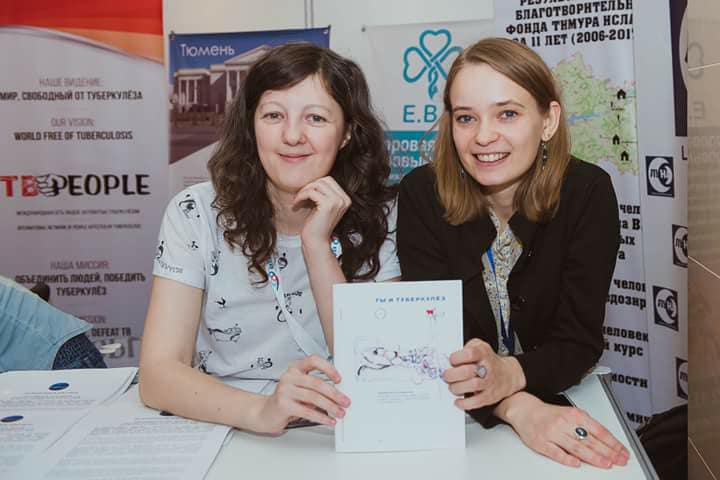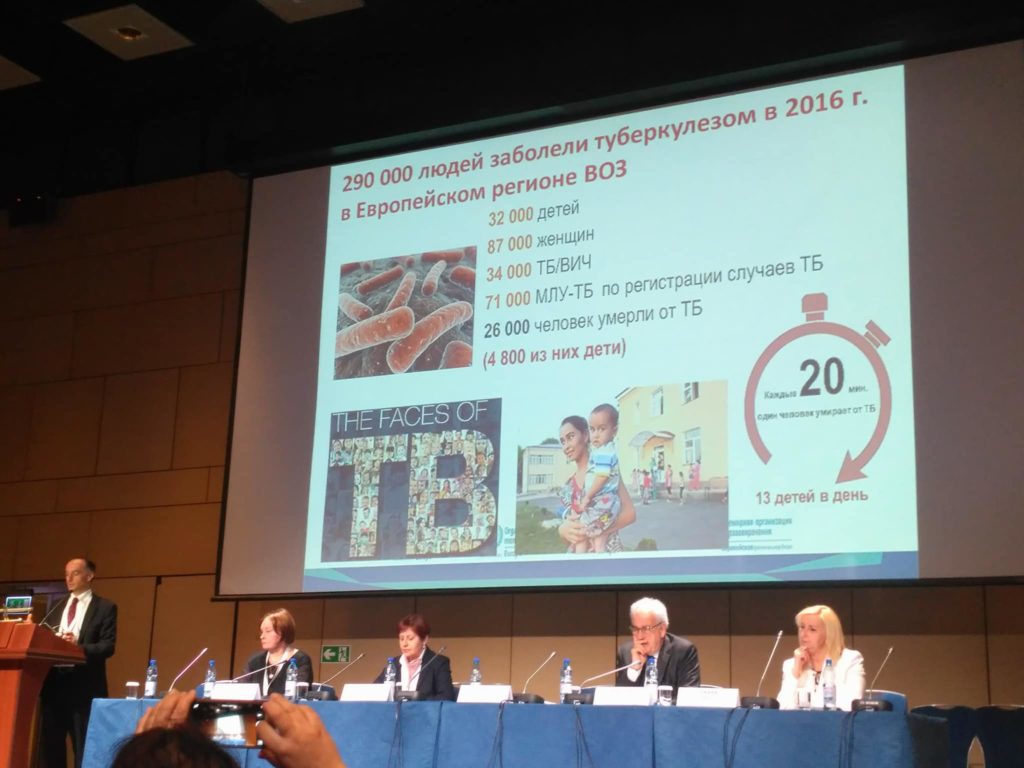Natalia Sidorenko, expert of the regional group of the Partnership Program on tuberculosis, shared her insights and observations from the HIV/AIDS Conference in the EECA region with MinusVirus.
According to the WHO Europe Office, by 2015 the number of HIV/TB co-morbidity cases increased by 40% compared to 2011. For people living with HIV, the risk of the TB treatment failure is 7 times higher than for HIV-negative people. In 2016, 34,000 out of 290,000 people who contracted tuberculosis in the European Region were HIV-positive. To change the situation, early initiation of antiretroviral therapy, availability of modern HIV and tuberculosis testing methods and new approaches to prevent interruptions in the treatment of tuberculosis are needed.

Наталья Сидоренко. Фото: evanetwork.ru
Within the framework of the EECAAC-2018 conference held on April 18-20, the topic of the prevention, diagnosis and treatment of tuberculosis in HIV-positive people was covered both in the framework of the conference events and in the published materials of the Conference Proceedings. On the second day of the conference, a round table was held on the “Issues to be solved in the organization of TB care for HIV-infected persons”. Round table reports are of great interest to the scientific community. Within the framework of the reports, clinical cases of pulmonary and extrapulmonary TB in PLWH are presented, the results of studies on the situation with TB/HIV co-morbidity in the penitentiary system of the CIS countries are demonstrated, and the methods of TB radiotherapy among patients with various immune status are demonstrated. However, despite the tendency to increase the meaningful participation of patients in all important processes, including conferences, thanks to the TBPeople actions, on EECAAC-2018 doctors and patients participating in the HIV/TB topic seemed to exist in two parallel words.

TВ People representatives at EECAAC 2018. Photo: Natalia Sidorenko
Unfortunately, only one round-table report considered the impact of the level of patient knowledge on their adherence to the use of TB drugs for the treatment of latent tuberculosis infection, as well as the relationship between the financial situation of patients and the frequency of visits to AIDS centers. None of the doctors raised the issue of interruptions in the supply of TB drugs, the frequent absence of drugs for the side effects management in the TB facilities, the impact of these disruptions on patient adherence and treatment outcomes. In the EECA region the patients are obviously excluded from the tuberculosis treatment process as its equal participants, medical workers often do not pay close attention to problems that are of concern for patients and affect the positive outcome of treatment. Practically none of the reports of medical specialists at the conference touches upon the motivation of patients with HIV infection to regularly undergo a TB screening test, as well as patient retention in tuberculosis treatment programs.

Report by Masoud Dara “WHO Strategy in overcoming MDR-TB in Eatern Europe and Central Asia”. Photo: Natalia Sidorenko.
At the parallel session No. 26, “HIV infection and TB” in the report “WHO Strategy in overcoming MDR-TB in Eastern Europe and Central Asia”, Masoud Dara, the head of TB and MDR-TB control programs, WHO Regional Office for Europe, presented current statistical information about the TB epidemic in the EECA region and provided details about the strategic activities of the WHO aimed at countering the epidemic.
The statements on the involvement of civil society organizations in all programmatic planning activities and on the established relationship with NGOs were especially encouraging. Early diagnosis and the provision of a full cycle of treatment through patient-centered care are mentioned, among other things, as future steps in the fight against TB.
Irina Vasilieva, the chief part-time specialist of the Ministry of Health of the Russian Federation indicated the HIV/TB comorbidity in her report as one of the main problems of effective tuberculosis control in Russia and globally.
The proportion of TB/HIV patients among new TB cases in Russia is steadily increasing. In 2014 in Russia, more than 30% of all deaths among PLWH were caused by TB. Almost 84% of patients with HIV/TB have a history of viral hepatitis C. As a rule, drug-resistant forms of tuberculosis are more common among patients with HIV infection and tuberculosis. Given the particularities of the spread of the HIV epidemic in Russia, it is clear that a significant proportion of patients with HIV/TB are people who use drugs. However, when asked how to solve the problem of adherence to the TB treatment among drug dependent patients in the absence of drug treatment in Russian TB hospitals, Irina Anatolievna answered that there are separate centers where narcological assistance is available (according to the Monitoring of the Conformity of TB Institutions to the Procedure of providing assistance to patients with TB, narcologists and psychiatrists were available only in 2 medical institutions out of 28 at the time of the monitoring – NS) and it is a very serious problem, which the TB doctors are trying to solve jointly with the narcology specialists.
Timur Abdullayev (representative of the Eastern Europe and Central Asia Network of TB Survivors – TB People) presented a report on the topic “Accessibility of TB treatment drugs from the community perspective” in parallel session No. 13 “The role of the community in the prevention, diagnosis and access to treatment of HIV and related diseases”. Timur spoke about the importance of the patient community activities in providing drugs for the treatment of tuberculosis. There is a limited number of combination drugs, so patients are forced to take whole handfuls of pills, especially if they have drug-resistant tuberculosis. There are problems with the availability of drugs to mitigate side effects. There are issues about the quality of medicines. During another, no less interesting Panel discussion on “The role of the community in rapid HIV and co-morbidities testing”, Timur touched on the issue of the lack of available methods of rapid TB testing in the EECA region both in medical institutions and on community basis.
An important topic is the prevention of tuberculosis among migrants, and several examples of best practices were presented under this topic. For example, the report “Involving Migrants in Preventive Sessions on HIV, Tuberculosis and STIs in Railway Transport: Innovation and Efficiency” by Ilkhom Takhimov, Red Crescent Society of Tajikistan, Head of the Health Department of Tajikistan was interesting in this aspect.
Employees of the Red Crescent Society carry out information work with migrants on the “Dushanbe-Moscow” train throughout the trip, as the long journey and the absence of a distracting factors contribute to the assimilation of knowledge and building of trust.
Special mention should be made of Actions for transboundary control and treatment of TB, MDR-TB and TB/HIV among labor migrants in Kazakhstan. As part of these activities, since 2012, 1607 TB patients have been identified, and the registration of tuberculosis cases among external migrants has increased 4-5-fold.


 ПОИСК ПО САЙТУ
ПОИСК ПО САЙТУ  поиск по ресурсному центру
поиск по ресурсному центру 



